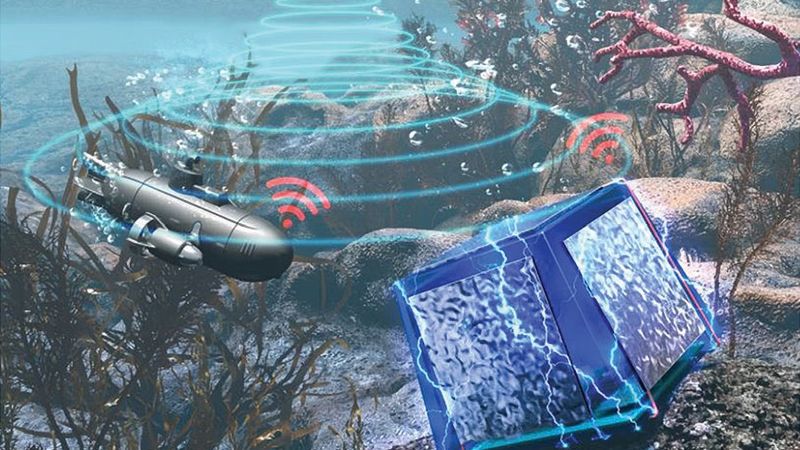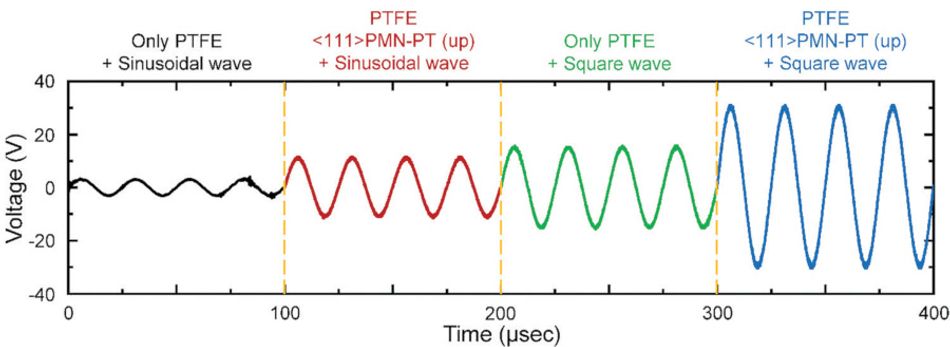A move to ultrasonic acoustics for wireless energy transmission could power implants, underwater sensors, and more
A team of researchers in Korea has been working on functional acoustic energy transmission (AET) systems, and their latest paper details a major breakthrough: Prototypes capable of powering LEDs, sensors, and Bluetooth transmitters at range and through materials include metal, tissue, and water.

An artist's impression of the proposed AET system being used to drive both underwater sensor networks and autonomous underwater vehicles (AUVs), using nothing but ultrasound signals from a passing boat on the surface.
Wireless energy transmission, the dream of visionaries including Nikola Tesla with his Wardenclyffe Tower experiments, is today a reality. From completely-sealed electric toothbrushes to smartphones capable of charging when just thrown down onto a mat at the end of the day, there are plenty of examples of commercially-viable wireless power systems in everyday life — and still more on the horizon, including proposals for energising electric vehicles while they travel or robots as they roam.
The majority of these, however, rely on electromagnetic transmission — an approach which works perfectly well over the air, but begins to encounter difficulties when faced with transmission through other media such as living tissue or water. What could be an ideal way to charge implanted electronics or undersea sensor networks becomes significantly more challenging — which is why a team of researchers from a number of Korean institutions have turned to acoustic energy transfer instead, switching from electromagnetic radiation to ultrasound as the energy source.
The sound of power
The team, led by the Korea Institute of Science and Technology (KIST), isn’t the first to look at — or even succeed at — wireless energy transmission via ultrasound. Previous approaches, however, have been extremely limited in either the distance over which the energy can be transmitted or the amount of energy usable at the receiver — or, typically, both.
The prototype developed by the researchers, by contrast, offers a considerable improvement over the state-of-the-art in both respects. Built using a five-layer design — a flexible electrode upper, a fixed area, a triboelectric layer, a novel ferroelectric layer, and a bottom electrode — the receiver sheets generate energy through movement induced by a 40kHz ultrasound signal, but represent only part of the gain in performance reported in the work.

The remainder, the team explains, comes from a switch from a sinusoidal acoustic wave to a square wave — an approach which, combined with the addition of piezoelectric PNM-PT crystals to the receiver as the ferroelectric layer, considerably boosts the output voltage available to connected electronics. Interestingly, the researchers conclude that the boosted voltage comes not from the piezoelectric effect directly but from a boost to the triboelectric effect.
“It can be seen that our device is mode-free,” the team explains, “and frequency independent. This is vital for its practical use, because unlike piezoelectric type receivers, our device does not necessitate a precisely matched ultrasound transducer.”
Switched on by sound
To prove not only the core concept but also its applicability in simulations of various real-world use cases, the team built receiver prototypes and placed them in a range of materials: A lump of pork, used as a stand-in for human tissue in the case of recharging or directly powering implanted electronic devices; metal, acrylic, medium-density fiberboard (MDF), and plywood, to show its ability to transmit energy through a range of housing materials including those which would block electromagnetic radiation; and a tank of water, to showcase the system’s potential for powering sub-aquatic drones or sensor networks ill-suited to other wireless energy transfer approaches.

The results are undeniably impressive. The body-implanted version proved capable of delivering sufficient power to drive implantable electronic devices without damage to the surrounding tissue and with the ultrasound emissions kept well within FDA-approved limits for use on patients; the system successfully transmitted though all the housing materials, representing the bulk of materials used in commercial and industrial electronic systems; and energy transmission worked perfectly through water.
The latter experiments are worth further analysis. The team created a 3D-printed trapezoidal structure with prototype energy receiving sheets making up five of its faces, then fitted a range of wireless sensors designed for water quality monitoring — measuring metrics including temperature, carbon dioxide levels, pressure, and humidity. These were then powered using a transmitter 6cm (around 2.4") away — “an order longer,” the team notes, “than the previous report.”
In further testing the team directly drove two matrices of 200 LEDs each at a brightness high enough to be observed under laboratory lighting, before concluding with a “conclusive demonstration” as to the approach's suitability for practical use: The replacement of the battery in a commercial Texas Instruments CC2650 Bluetooth Sensor Tag with an acoustic energy receiver which was capable of triggering Bluetooth transmission of sensor readings to a nearby tablet computer within a second of the ultrasound transmitter being energized.

“This study demonstrated that electronic devices can be driven by wireless power charging via ultrasonic waves,” says Hyun-Cheol Song, PhD, who led the project. “If the stability and efficiency of the device are further improved in the future, this technology can be applied to supply power wirelessly to implantable sensors or deep-sea sensors, in which replacing batteries is cumbersome.”
The team’s work has been published under closed-access terms in the journal Energy & Environmental Science.
Reference
Hyun Soo Kim, Sunghoon Hur, Dong-Gyu Lee, Joonchul Shin, Huimin Qiao, Seunguk Mun, Hoontaek Lee, Wonkyu Moon, Yunseok Kim, Jeong Min Baik, Chong-Yun Kang, Jong Hoon Jung, and Hyun-Cheol Song: Ferroelectrically augmented contact electrification enables efficient acoustic energy transfer through liquid and solid media, Energy & Environmental Science, Iss. 3 2022. DOI 10.1039/D1EE02623B.
